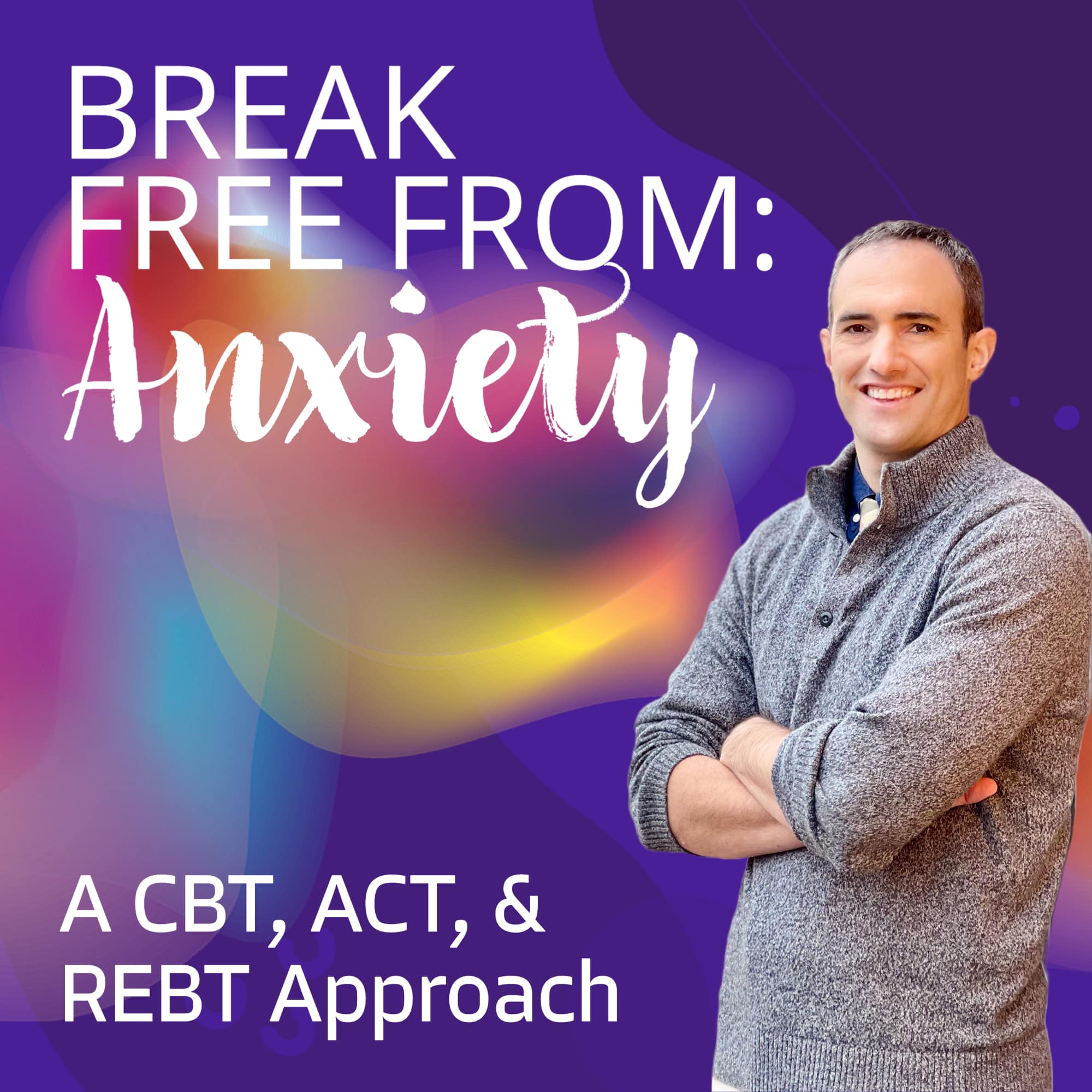In this article, Dr. Bruce Bassi, psychiatrist with TelepsychHealth, gives an overview of anxiety treatment options. This article is part of a larger, comprehensive article on mental health treatments.
KEY TAKEAWAYS
- Treat the person, not the anxiety. Find options that increase function, well-being, which in turn will dial down symptoms.
- A variety of treatment options exist: medications, supplements, self-help, and psychotherapy.
- Psychotherapy options such as CBT, ACT, and REBT are great choices for treating anxiety.
Why does Dr. Bassi believe in ACT?
Acceptance and commitment therapy (ACT) really hits the “logical” and “makes sense” buttons for me. I’ve become fully in agreement that the more I focus on anxiety, frustration, the more out of control it becomes! This is the basic premise of ACT. I’ve found that when I shrug my shoulders toward those intrusive thoughts, I am able to finally let them go and do whatever I want.
- Simple, practical, easy to understand techniques
- Evidence based
- Psychological flexibility is exactly what is needed to get through difficult times
Table of Contents
1. What is acceptance therapy?
2. What is the history of ACT and who is Steven Hayes?
3. What is radical acceptance therapy?
4. Who is acceptance and commitment therapy useful for?
5. When should you use acceptance and commitment therapy?
6. What is the difference between acceptance and commitment therapy (ACT) vs CBT?
7. Technique #1: Cognitive Defusion
8. Technique #2: Reframing the struggle switch
9. Technique #3: Mindful Observation
10. Technique #4: Developing value-based committed action
11. Are there any materials that are easy to use that incorporate ACT techniques?
What is acceptance therapy?
ACT stands for Acceptance and Commitment Therapy, which is a type of psychotherapy that emphasizes mindfulness, acceptance, and values-based action to promote psychological flexibility and well-being.
What should you expect in an ACT thereapy session?
In an ACT therapy session, you can expect to work collaboratively with a trained therapist who will guide you through the process of learning and applying ACT principles and techniques. The exact format and content of a therapy session will vary depending on your individual needs and goals, as well as the specific approach of your therapist.
Generally, an ACT session may begin with a brief discussion of your current concerns and experiences, as well as an exploration of your values and goals. From there, your therapist may introduce mindfulness exercises, which can help you become more aware of your thoughts, feelings, and bodily sensations in the present moment. This can include techniques like focused breathing or body scanning.
Next, your therapist may guide you through exercises designed to help you identify and accept difficult thoughts and feelings, rather than trying to avoid or suppress them. This can involve visualization techniques or cognitive defusion exercises, which aim to help you relate to your thoughts and feelings in a more flexible and accepting way.
Finally, your therapist may work with you to identify values-based actions and goals that are important to you, and help you develop strategies for taking meaningful steps towards these goals. This may involve goal-setting exercises, behavioral activation strategies, or other techniques to promote psychological flexibility and well-being.
Overall, the goal of ACT therapy is to help you develop greater psychological flexibility and resilience, so that you can live a more meaningful and fulfilling life, even in the face of difficult thoughts, feelings, and circumstances.
Psychological flexibility: Psychological flexibility is the ability to adapt and respond to different situations and challenges in a flexible and adaptive way. This involves being able to shift your thoughts and behaviors to align with your values and goals, even when faced with difficult or unexpected circumstances. Psychological flexibility is a key component of Acceptance and Commitment Therapy (ACT), which is a type of therapy that focuses on helping individuals build greater psychological flexibility.
Resilience: Resilience is the ability to bounce back and recover from difficult or stressful situations. This involves being able to adapt and cope with adversity, and to maintain a sense of well-being in the face of challenges. Resilience is often seen as a positive trait that can help individuals to thrive and succeed in different areas of life, including work, relationships, and personal goals.
What is the history of ACT and who is Steven Hayes?
The history of ACT can be traced back to the 1980s and 1990s, when Steven C. Hayes and his colleagues began developing the approach as an alternative to traditional cognitive-behavioral therapy (CBT).
Steven C. Hayes is an American psychologist and professor of psychology at the University of Nevada, Reno. He is one of the co-founders of ACT and is widely recognized as one of the leading figures in the development and promotion of the approach. Hayes began his academic career in the 1970s, focusing on the behaviorist principles of language and cognition. He later became interested in the limitations of traditional CBT approaches, which he felt were overly focused on symptom reduction and did not address the broader context of a person’s life and experiences.
Who developed acceptance and commitment therapy?
Along with colleagues like Kelly G. Wilson and Kirk Strosahl, Hayes began to develop a new approach to psychotherapy that emphasized acceptance and mindfulness-based techniques, while also incorporating behavioral and cognitive strategies. This approach eventually became known as ACT, and it has been widely researched and applied in a variety of settings, including clinical, educational, and organizational contexts. Today, ACT is recognized as one of the major “third wave” psychotherapies, alongside approaches like dialectical behavior therapy (DBT) and mindfulness-based cognitive therapy (MBCT).
What is radical acceptance therapy?
Radical acceptance therapy is a therapeutic approach that emphasizes the importance of accepting and embracing difficult emotions, experiences, and circumstances, rather than trying to resist or avoid them. It is often used in the treatment of conditions like borderline personality disorder, post-traumatic stress disorder, and addiction.
Radical acceptance therapy is based on the idea that trying to fight or change reality can create unnecessary suffering and limit our ability to live a fulfilling life. Instead, the goal is to develop a more accepting and compassionate attitude towards ourselves and our experiences, while also recognizing our own power to make meaningful changes.
The practice of radical acceptance often involves mindfulness techniques, such as meditation or body scanning, which help us become more aware of our thoughts and feelings without judgment or attachment. It may also involve cognitive restructuring, which helps us challenge negative or unhelpful beliefs and attitudes that may be contributing to our suffering.
Overall, radical acceptance therapy aims to help individuals develop greater emotional resilience, self-awareness, and compassion, so that they can live a more fulfilling and satisfying life, even in the face of difficult circumstances.
Who is acceptance and commitment therapy good for?
Acceptance and Commitment Therapy (ACT) has been found to be effective in treating a wide range of mental health conditions:
- anxiety disorders
- depression
- chronic pain
- substance abuse
- many others.
It can also be helpful for individuals who are seeking:
- personal growth
- self-improvement
- greater sense of purpose and meaning in their lives.
ACT is particularly well-suited for individuals who are struggling with rigid, inflexible thinking patterns or who find themselves caught up in negative thoughts and emotions. It can also be beneficial for individuals who are looking for a more holistic and values-driven approach to psychotherapy, one that emphasizes mindfulness, acceptance, and self-compassion.
ACT can be adapted to suit individuals of all ages, backgrounds, and levels of functioning, and can be delivered in a variety of settings, including individual therapy, group therapy, and self-help programs. However, it is important to note that ACT may not be appropriate for everyone, and that individuals with certain mental health conditions may require more specialized or intensive forms of treatment.
When should you use acceptance and commitment therapy?
Acceptance and Commitment Therapy (ACT) can be used in a variety of contexts, and it may be beneficial for individuals who are struggling with various mental health conditions and want to live fully with acceptance. Here are a few situations where ACT can be helpful:
- Managing anxiety or depression: ACT can help individuals learn to accept their difficult thoughts and feelings, instead of trying to avoid or control them. This can be particularly helpful for those struggling with anxiety or depression, as these conditions can be characterized by a tendency to avoid certain situations or experiences.
- Coping with chronic pain: ACT can be an effective treatment for chronic pain. By learning to accept their pain and focus on what they value in life, individuals can improve their overall quality of life and reduce their suffering.
- Enhancing personal growth: ACT can help individuals clarify their values and make choices that align with what is most important to them. This can help them live a more meaningful and fulfilling life.
- Improving relationships: ACT can help individuals learn to communicate more effectively, set boundaries, and show empathy toward others. These skills can be helpful in improving all types of relationships, including romantic relationships, friendships, and family relationships.
In summary, ACT can be beneficial in a wide range of situations, but it may be especially helpful for managing anxiety and depression, coping with chronic pain, enhancing personal growth, and improving relationships. It is important to work with a trained therapist who can guide you through the ACT process and tailor the therapy to your specific needs.
What is the difference between acceptance therapy vs CBT?
Acceptance and Commitment Therapy (ACT) and Cognitive Behavioral Therapy (CBT) are two types of psychotherapy that are often used to treat mental health conditions. While there are some similarities between these two approaches, there are also some key differences.
- Focus: CBT primarily focuses on identifying and changing negative thoughts and beliefs that are contributing to a person’s distress. ACT, on the other hand, aims to help individuals learn to accept difficult thoughts and feelings, rather than trying to change or eliminate them.
- Techniques: CBT uses a variety of techniques to help individuals challenge and modify negative thoughts, including cognitive restructuring, behavioral experiments, and exposure therapy. In contrast, ACT uses techniques such as mindfulness, acceptance, and values clarification to help individuals learn to accept their thoughts and feelings.
- Goals: The ultimate goal of CBT is to help individuals reduce their symptoms and improve their overall mental health. ACT, on the other hand, aims to help individuals live a more meaningful and fulfilling life, even in the presence of difficult thoughts and feelings.
- Theory: CBT is based on the idea that our thoughts, feelings, and behaviors are interconnected and that by changing one, we can change the others. ACT is based on the idea that the human mind is naturally wired to avoid pain and seek pleasure, but that this tendency can sometimes lead to more suffering.
In summary, both ACT and CBT can be effective treatments for a range of mental health conditions, but they approach treatment in slightly different ways. The following techniques will help you understand how does acceptance commitment therapy work.
Group Therapy
Can be incredibly helpful to meet others who developed ACT skills. TelepsychHealth offers group therapy to help learn ACT techniques.
Acceptance Therapy Technique #1: Cognitive Defusion
Cognitive defusion is a technique used in Acceptance and Commitment Therapy (ACT) to help individuals develop a more flexible relationship with their thoughts. Here are some simple instructions for practicing cognitive defusion:
- Identify a thought: Choose a thought that you often have that causes you distress or interferes with your daily life.
- Notice the thought: As you bring the thought to mind, notice how it affects you. How does it make you feel? What physical sensations do you experience?
- Say the thought out loud: Repeat the thought out loud, slowly and clearly. As you say the thought, notice how it sounds and feels to say it out loud.
- Add “I’m having the thought that…” in front of the thought: This helps you acknowledge that the thought is just a thought, and not necessarily true or important.
- Repeat the thought with a silly voice or accent: Saying the thought in a silly voice or accent can help you see it in a different light and reduce its power over you.
- Repeat the thought rapidly for 30 seconds: This can help you become more comfortable with the thought and reduce its emotional impact.
By practicing cognitive defusion regularly, you can learn to see your thoughts as just thoughts, rather than as absolute truths that must be acted upon. This can help you develop a more flexible relationship with your thoughts and reduce their negative impact on your life. It is important to work with a trained therapist who can guide you through this process and tailor the therapy to your specific needs.
Acceptance Therapy Technique #2: Reframing “Struggle Switch”
Changing the way you think about your thoughts is known as reframing. Your thoughts are strongly influenced by your previous experiences, mood, and the context of your life. Genetics also play a role in your thought processes. For example, if you’re walking to work and someone bumps into you, your reaction will vary depending on whether the person is a child, adult, or elderly. We tend to assume that people’s actions are intentional and react accordingly.
However, it’s important to realize that we don’t have to react to every thought we have. We can acknowledge a thought without giving it power over us. To prevent overreacting, slow down and gather more information about the thought. This will help you distinguish between acknowledging a thought and reacting to it.
Reframing anxious or intrusive thoughts can be an effective way to reduce their impact on your life. Here are some steps you can take to reframe your thoughts:
- Identify the thought: Start by identifying the anxious or intrusive thought that is causing you distress. Write it down if it helps you remember it.
- Challenge the thought: Ask yourself if the thought is based on reality. Is it a fact, or is it just an assumption or interpretation? Can you find evidence to support or refute the thought?
- Reframe the thought: Once you have challenged the thought, reframe it in a more balanced or positive way. For example, if you have the thought “I’m going to fail this test,” you could reframe it as “I have studied and prepared for this test, and I will do my best.”
- Practice the new thought: Repeat the reframed thought to yourself several times, or write it down and read it whenever the anxious or intrusive thought comes to mind.
- Take action: Finally, take action based on the new thought. Use it as a motivation to do something productive or positive. This will help reinforce the new thought and reduce the impact of the old thought.
Remember that reframing takes practice and patience. It’s important to work with a therapist who can guide you through the process and provide support and encouragement. In addition to reframing, other techniques such as mindfulness and relaxation can also be helpful in managing anxious or intrusive thoughts.
Acceptance Therapy Technique #3: Mindful Observation
You can learn to manage your anxiety by observing it mindfully. Mindful observation involves noticing and accepting your anxious thoughts and feelings without judgment. This allows you to step back from them and gain a better understanding of them.
To observe your anxiety mindfully, start by finding a quiet and comfortable place to sit or lie down. Close your eyes and take a few deep breaths. Focus your attention on your breath and the sensations in your body.
As anxious thoughts or feelings arise, simply observe them without trying to change or control them. Notice where in your body you feel the anxiety, and describe it to yourself without judgment. You can use words like “tension,” “tightness,” or “fluttering” to describe the sensations.
As you continue to observe your anxiety mindfully, you may notice that it begins to dissipate on its own. You can also use your breath to help calm your body and mind. Breathe in slowly and deeply, hold for a few seconds, and then exhale slowly.
Remember that mindful observation takes practice and patience. It’s okay if your mind wanders or if the anxiety doesn’t go away immediately. The key is to keep observing without judgment and to be kind and gentle with yourself.
Acceptance Therapy Technique #4: Value-Based Committed Action
Developing value-based goals and committed action are two core components of Acceptance and Commitment Therapy (ACT). Here’s an explanation of each:
1. Value-based goals: In ACT, value-based goals are those that align with your personal values and the things that are most important to you in life. These goals are different from traditional goals in that they are not focused on achieving a specific outcome or result. Instead, they are focused on living a fulfilling and meaningful life.
To develop value-based goals, you first need to identify your values. This can be done through reflection, self-assessment, or working with a therapist. Once you have identified your values, you can then set goals that are aligned with those values. For example, if one of your values is family, a value-based goal might be to spend more quality time with your loved ones.
2. Committed action: Once you have identified your value-based goals, committed action involves taking concrete steps to achieve those goals. This may involve making changes to your behavior, habits, or thought patterns. The key is to take action that is consistent with your values, even if it feels uncomfortable or challenging.
Committed action can be broken down into smaller, achievable steps. This helps to make the process of change more manageable and less overwhelming. It’s also important to track your progress and celebrate small successes along the way.
By developing value-based goals and taking committed action to achieve them, you can create a sense of purpose and meaning in your life. This can help to reduce symptoms of anxiety, depression, and other mental health concerns, and improve overall well-being.
Are there any materials that are easy to use that incorporate ACT techniques?
1. ACT Course: Get Unstuck and Live Your Life This course contains over 2 hours of the most useful ACT concepts for managing intrusive thoughts. The course is presented in a structured and organized manner, with clear objectives and learning outcomes for each module. The course material is also accompanied by interactive exercises, prompts, and tools that allow you to apply the concepts to your own own life.

 Bruce Bassi
Bruce Bassi





